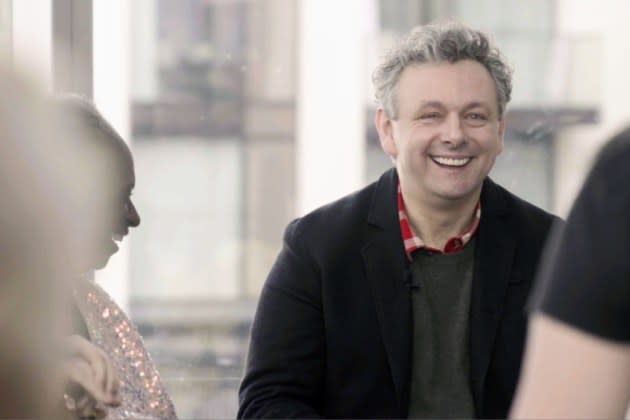How ‘The Assembly’ Producers Convinced Michael Sheen to Participate in a Three-Hour Grilling With 30 Neurodivergent Journalists: ‘It’s an Interview Without a Safety Net’
- Oops!Something went wrong.Please try again later.
- Oops!Something went wrong.Please try again later.
- Oops!Something went wrong.Please try again later.
- Oops!Something went wrong.Please try again later.

Celebrity interviews are usually a highly produced, intense tête-à-tête – not unlike the one Michael Sheen portrayed in “Frost/Nixon,” Peter Morgan’s dramatization of David Frost’s interviews with Richard Nixon.
But “The Assembly,” in which Sheen is grilled by a group of around 30 neurodiverse novice journalists, dispenses with the idea of a traditional celebrity interview altogether. The format is based on a French series called “Les Rencontres du Papotin,” which has seen French public figures from President Emmanuel Macron to “Call My Agent’s” Camille Cottin interrogated by a collective of participants with autism or learning disabilities.
More from Variety
BBC Launching Kids Subscription Service in Korea - Global Bulletin
BBC Has 'Significant' Ambitions for AI, Director General Tim Davie Says
Clémence Poésy, Emily Beecham Join James Norton in Period Drama 'King and Conqueror'
Disability-led U.K. production outfit Rockerdale Studios (“Mission: Accessible”) recently recorded a one-off special in London with Sheen, to air in the U.K. on Friday during Autism Awareness Week. While the three-hour recording will be cut down to less than an hour for broadcast, there are hopes that if it works, it could be picked up for a full series (the French show, now in its second season, has already been adapted for Poland and Denmark).
For Rockerdale founders Michelle Singer and Stu Richards, the production required an extra level of care for the participants and crew — the disability representation on screen extended behind the camera too.
Singer sat down with Variety shortly after wrapping to discuss how she and Richards managed to convinced both Sheen and the show’s collective of apprentice interrogators to get on board.
How did you hear about “Les Rencontres du Papotin”?
We’re a disabled-led production company, and our U.S. agent was aware of the format and suggested us as the right production partner for the U.K. Crucially, this is not a documentary, it’s not a factual show — it’s entertainment and we’re an entertainment and comedy company. What you want to do is strip away all of the artifice of an interview and get away from all the standard questions that we hear that person answer in every other interview. And crucially, they’re not there to plug anything. So now we have the exciting conditions for something more unpredictable — because it’s not rehearsed. It’s like an interview without a safety net. And there’s something quite exciting about the celebrity not being able to prepare anything, not knowing what’s going to come next. Nobody knows, actually. And our collective, by the nature of autism, for the most part there’s no filter. Nobody’s trying to catch anybody out. There’s no agenda. And so it’s a really exciting environment in which to watch the magic and the mischief and the questions take place.
Was it difficult to get Michael Sheen to take part?
Michael Sheen is so right for this particular BBC special and he’s also a very thoughtful and intelligent guy. And not only does he have very strong beliefs, which he communicates, but he also has the ability to be very funny and very playful too and that makes him ideal. Questions will in a heartbeat go from truly profound to utterly frivolous. So to be able to go with that particular flow is really special. There are other publicists, agents, managers of really significant named talent who are very up for being available should we move to series.
What are some of the considerations when you are producing a show with 30 neurodiverse novice journalists?
Everything from the building in which you film and doing a risk assessment on that, to the background checks of any of your main featured contributors, to getting people to and from a location. On the one hand, we’re all used to doing these things all the time with every TV show, and yet with this particular collective everything pretty much needs to be truly considered on a step-by-step basis.
Is that why the shoot wasn’t in a traditional studio?
That’s a really specific thing around sensory overload. There are no artificial lights used whatsoever, so the location needs to be somewhere where there is just natural light. It’s also about a kind of a naturalness, and certainly putting our contingent at ease, but also that adds to a particular kind of aesthetic. It means that the thing looks and feels different to a more typical celebrity interview.
Were all the contributors familiar with Sheen?
A lot of them knew who he was already and had some astonishing questions. One guy in particular, who’s a real “Top Gear” fan, knew the speed at which Michael Sheen had completed his [lap when he appeared as a guest in 2013]. There were lots of fans of the “Twilight” series or various other shows of his. Somebody who was obsessed with his “Simpsons” episode – understandably!
How did you cast the contributors?
We started the development process last May/June and we spoke to a variety of different autism charities. The people that run these organizations were initially quite skeptical because [they] get approached a lot by telly folks saying, “Hey, we’d like to turn our cameras on [your collective].” What you don’t want is some weird mawkishness, you don’t want exploitation. [Here the contributors] really are the ones in charge. They’re in the positions of power, not the celebrity. That’s the secret sauce. All the fun and the mischief and the curiosity — that all will translate into the show.
This interview has been edited and condensed for clarity.
Best of Variety
Sign up for Variety’s Newsletter. For the latest news, follow us on Facebook, Twitter, and Instagram.
